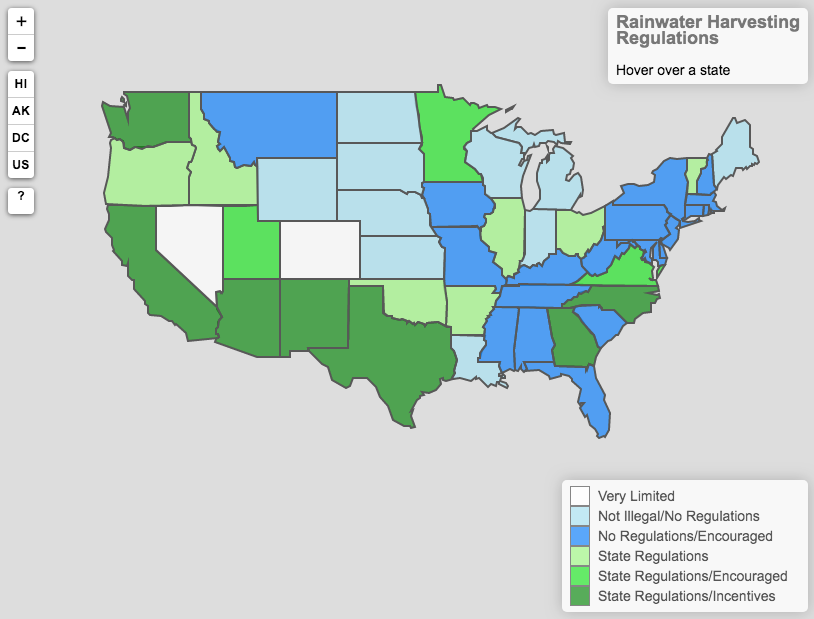Rainwater Harvesting Policy and Legal Issues
New Mexico
Rainwater/Snowmelt Harvesting Policy of the New Mexico Office Of The State Engineer, 2004:
"The New Mexico Office of the State Engineer supports the wise and efficient use of the state's water resources and, therefore, encourages the harvesting, collection and use of rainwater from residential and commercial roof surfaces for on-site landscape irrigation and other on-site domestic uses. The collection of water harvested in this manner should not reduce the amount of runoff that would have occurred from the site in its natural, pre-development state. Harvested rainwater may not be appropriated for any other uses." (Reference)
New Mexico encourages the use of rainwater harvesting and use. See their Water Conservation - Roof-Reliant Landscaping page with useful resources, tips, and how-to information.
Arizona
Rainwater Harvesting in the Southwestern United States - A policy review of the Four Corners states, 2010, Todd L. Gaston:
"Statutory law in Arizona has been interpreted to permit the harvesting of rainwater and consequently there has been no successful legal challenge to rainwater harvesting in the state. Further affirmation of the legality of rainwater harvesting in the state is the creation of a tax credit for water conservation systems that includes rainwater harvesting structures." (Reference)
Colorado
Colorado State law had until recently prohibited rainwater collection in barrels and cisterns. This has changed. House Bill 16-1005, effective August 10, 2016, allows precipitation to be collected from the rooftop of certain residential properties. http://water.state.co.us/SurfaceWater/RainwaterCollection/Pages/default.aspx
Kudos to those individuals who have helped change the law to be more reasonable. Although it is a vast improvement, there are still a few hang-ups in the recent legislation. Rainwater collection in barrels or cisterns is limited to single family residences and multi-family residences with fewer than four units. Only 110 gallons of rainwater may be stored on site at any time. This effectively prohibits rainwater to be used as the primary source for a residence because to do this you need a cistern with several thousand gallons of storage.
Here's the hydrological explanation of why rainwater harvesting should be completely legal: Think of the many small rains that generate enough concentrated water from a roof with rain gutters and a downspout to help fill a cistern, but not enough for the runoff to reach the groundwater. Most roof runoff soaks shallowly into the ground and is either lost to evaporation or consumed by vegetation. If this water were stored in a cistern, it would create a new supply of water that could be used by the household, and then directed to either the sewer or, (preferably) bio-retention basins in the landscape (in the case of greywater). This practice actually creates a new supply of water for the homeowner without taking from the groundwater supply, and her tail water (the part that goes down the drain) will help to increase the groundwater supply. By creating and using this new source of water, she will decrease her use of groundwater resources, not only leaving more water for the downstream users, but increasing their supply! Smart lady!
For a long time In Colorado, Rain Gardens have been OK. Curb cuts directing water to bio-retention basins are OK. Directing your downspout to a porous landscape detention basin is OK. These practices are all promoted by the U.S. E.P.A. as a sound stormwater mitigation strategy. Someday rainwater harvesting may become entirely legal in Colorado when enough people realize that a silly law that is not based on hydrological understanding forces society to throw away a very high quality source of water.


